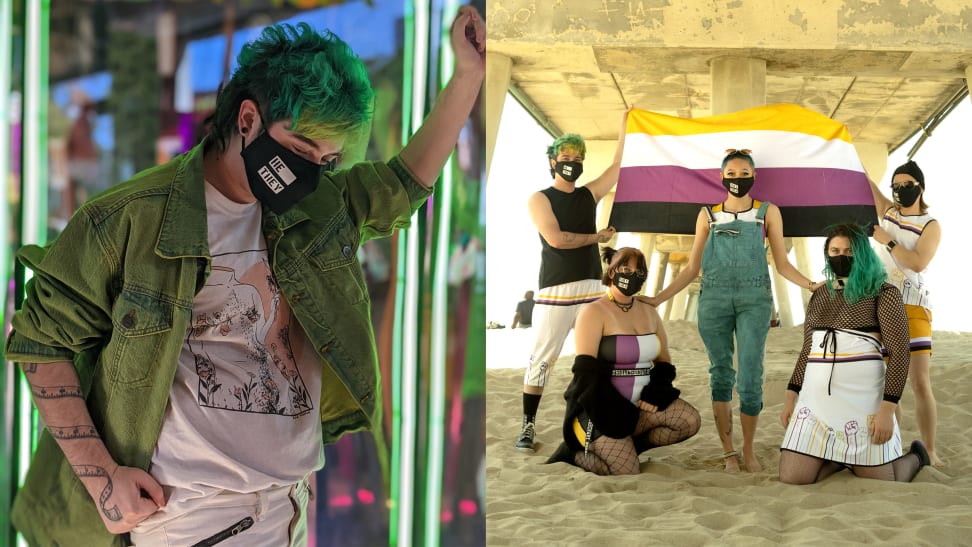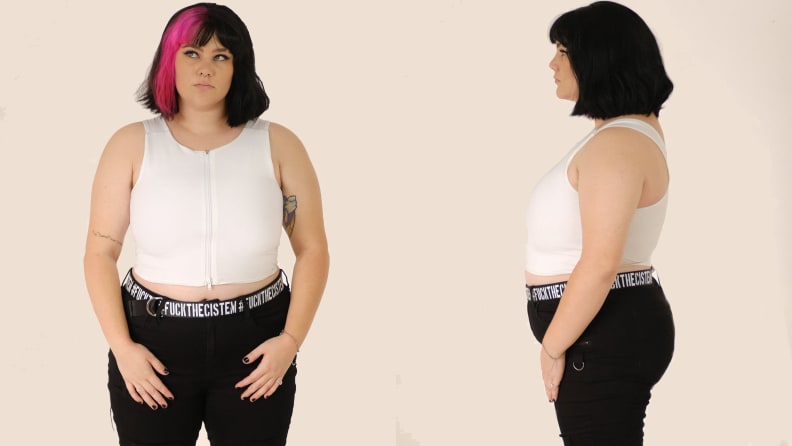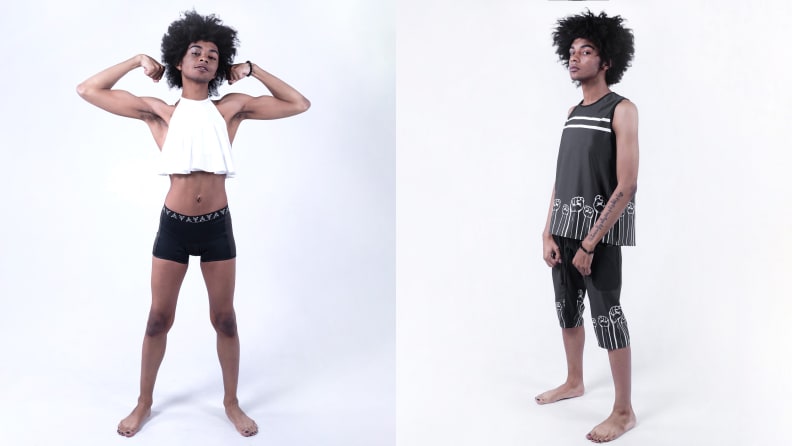GenderBender is reinventing gender-inclusive fashion
We spoke with brand creator Xandre Shephard to learn how.
 Credit:
GenderBender
Credit:
GenderBender
Products are chosen independently by our editors. Purchases made through our links may earn us a commission.
GenderBender, a gender-inclusive fashion brand, started with an worn-out chest binder—i.e., an article of clothing that gently compresses breast tissue to reduce its appearance under clothes. In 2017, founder Xandre Shephard’s partner would wear his binder constantly, and it became so worn out that the fabric started falling apart. “At some point, I looked at the construction of it and I was like, ‘Why did they do this?’ So, I made him a binder that had more stretch where he needed it,” Shephard said. “And right away, once I got the fit right, he was like, this is the most comfortable binder I’ve ever worn.”
After attending the Fashion Institute of Design and Merchandising in Los Angeles, Shepherd—who now identifies as a transmasculine non-binary person—hadn’t come to terms with their own gender identity yet, and their goal was “to create an androgynous line, which was basically going to be more menswear for women.” But as they got started in this process and realized how underrepresented the trans and nonbinary communities were in the fashion industry—especially those who are plus-sized—they realized that it just wasn’t enough. Their brand had to be more and do more.
In 2018, GenderBender became a reality. Mostly run by Shephard, the company also employs a small Peruvian-family-owned factory in Los Angeles that takes care of the production, except for the custom orders, which Shephard does by hand. With tons of positive feedback from the queer community and beyond, Shephard continued inventing new products to turn the fashion industry on its head.
We spoke with founder Xandre Shephard on their experience single-handedly running this business and the difference they’ve made in the fashion industry and the queer community around the world.
Reviewed: What does creating clothing for the LGBTQ+ community mean for you?
Xandre Shephard, founder of GenderBender: Well for trans people, it’s really difficult to find clothes that fit our bodies correctly. For a trans man who goes and shops in the men’s section, the shirts aren’t going to fit over his chest correctly. Or, if a trans woman is shopping in the women’s section, a lot of times there’s issues with shoulders fitting correctly, pants having the right shape in the hip, and things like that, that I have been trying to tackle.
We started out with shapewear because the easiest way to solve that problem was just to try to fit into the male and female shape. Chest binders and tucking gaffs have always been a really important part of transitioning for many people, so we started with that. But as we grow and as I can hire people and just get funding and space for everything—because I’m just running out of my house—then I would like to start making a lot more clothing.
I want trans people to love their bodies. I don’t want them to think that I’m making these products so that they can hide their bodies or reshape their bodies. Trans bodies are beautiful and we’re just offering stuff that will make people feel even more euphoric.
There’s just a lot of things that you would think fashion is doing with unisex clothing, but it really isn’t. Unisex clothing is men’s clothing. But I’m trying to change that for my brand.

GenderBender's binders compress breast tissue to reduce its appearance under clothes.
R: It seems like many of those queer-owned businesses that are trying to be more inclusive of all bodies. Like Origami Customs does so by offering custom sizing, so clothes are really designed to fit and flatter someone’s unique shape.
XS: Absolutely. The issue is that it’s really hard for trans artists to get funding to get the efficiency in a business to manufacture at a large scale, so they really do have to do custom orders. So, the people who are doing that, for the most part, either have to charge a lot for the product because it’s handmade, or they are not charging a lot because they want to be accessible. That’s great, but it means that they aren’t making money.
As queer and trans artists, we need to value ourselves and have to start actually making money for the work that we’re doing, otherwise we’re not really helping the community, I think.
R: We’d love to know more about size ranges. There’s XS, XXL, and boyshorts go all the way up to 5XL—how did those size ranges come together?
XS: Bodies are very diverse. What we try to do when we test a new product is we’ll release it in a limited size range, usually XS to 2X, if not smaller. Every once in a while there’s a situation where the fabric is really expensive because we had to get it printed, so we’ll offer fewer sizes. Once we see that a product is selling well and [get feedback] on any changes I need to make to the fit, [we’ll do that] before doing a larger run.
Our bestsellers are chest binders, and so those we have from XXS to 6X because, of course, we want to be inclusive. The issue is just being able to afford to be inclusive because [maintaining] inventory is really expensive and takes up a lot of space.

"Trans bodies are beautiful and we’re just offering stuff that will make people feel even more euphoric." - Xandre Shephard
R: A lot of what you’ve created, it seems, comes from a desire to create things for the people you care about, to help them feel good in their bodies. Is there a product you’re excited about right now that’s very recent?
XS: Yes! A big issue that trans people have is finding swimwear that they can wear and not be misgendered or stared at or risk assault by going to the beach or trying to go to the pool. So, I wanted to make a swim binder that would attach to a tank top because there are swim binders out there but it’s obvious what they are and most people would get the impression that it’s a sports bra.
So, I developed one that is attached to a tank top in a way that it won’t pop out so if somebody already passes otherwise then they can wear this and nobody would be any the wiser that they’re hiding something.
Beyond that, I decided to develop my own [binding] tape, which we call T-Tape. I had some made in nylon, which is really soft and has fine fibers, and it has less stretch than TransTape, so it’s pretty much impossible to get blisters or harm the skin that you can by accident with TransTape. It’s also very binding and my favorite thing is just how incredibly soft it is.
R: How does tape differ from using a chest binder?
XS: The upside to using tape compared to chest binding is that you’re only compressing your breast tissue. A big issue with safety in chest binders is that you’re compressing your whole rib cage, and for some people, it can cause back pain and you have to take breaks.
You can shower in T-Tape, you can swim in it and it makes a fantastic swim solution for people who [find] that swim binders aren’t quite working for them. The tape that I made also has easier adhesive to remove.

GenderBender sells a variety of clothing—that's way more than just binders.
R: What is networking like within the queer community, and do you feel like social media platforms help or hurt that?
XS: The big thing I did, which might seem awkward, [was use OKCupid], the dating app. OKCupid allows you to filter by gender or who you’re interested in, and identify as transgender, as a transman, a transwoman, as nonbinary, it’s very specific. So, it’s a lot easier to find that and there’s also a checkbox [you can hit], so it won’t show you to straight people.
So, I did that and made it very clear in my profile that I was trying to meet new people in the community, that I wanted to get feedback, and to learn about the struggles people are having, so I could brainstorm on how to bring solutions for them as well as a way to get to know what skillsets other people have. It’s how I found the majority of the models I use on Instagram, and from there, the network kept expanding at a really rapid rate. And it’s been a lot of fun.
R: Any advice for those in the LGBTQ+ community who might be looking to start their own businesses?
XS: Network! If you don’t know other people or find other people you can rely on, even for advice, it’s very lonely. It’s incredibly lonely to feel like you’re going into a business where you’re probably not going to be able to get loans because the banks are going to say, “Oh, that’s not a thing that people need.” But it is.
I want to employ trans people, I want to empower trans people with jobs and job experience. It’s also just a lot better to work with people in the community that understand what I’m trying to do here.
Shop GenderBender here
The product experts at Reviewed have all your shopping needs covered. Follow Reviewed on Facebook, Twitter, and Instagram for the latest deals, product reviews, and more.
Prices were accurate at the time this article was published but may change over time.



